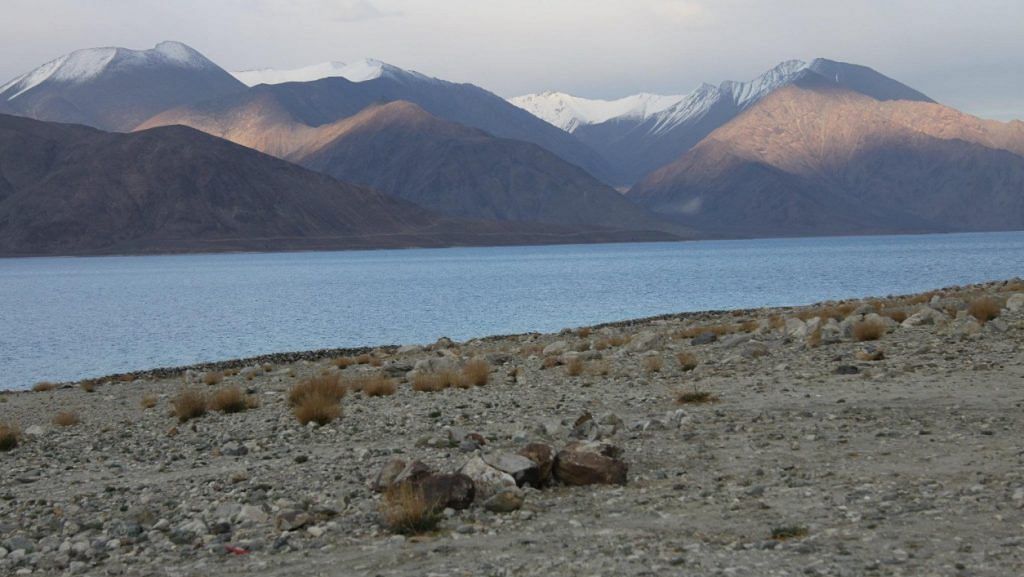New Delhi: The Chinese army’s presence has “thinned down” at Finger 4 in Ladakh’s Pangong lake area since Monday, but it continues to dominate the position, ThePrint has learnt. Disengagement in this troubled spot, sources said, will be a focus area during the next round of military talks at the corps commander level.
The talks are yet to be fixed, but they will be preceded by a meeting at a level below that of the corps commander, which will be held to notify the ongoing disengagement exercise in Ladakh.
The Pangong lake’s northern bank juts forward like a palm, and the various protrusions are identified as “fingers” to demarcate territory. India asserts that the Line of Actual Control is at Finger 8, but the Chinese Peoples Liberation Army (PLA) has moved eight kilometres into the area since May, until the point known as Finger 4.
“There has been some thinning down since Monday. Those who moved from Finger 4 are now based at Finger 5. The Chinese have not vacated Finger 4 and, hence, moving back of a few soldiers is not tangible,” said a source in the security and defence establishment.
The ongoing India-China disengagement exercise began Monday and is aimed at reducing tensions along several points of the LAC in Ladakh — Hot Spring, Depsang Plans, Galwan Valley and Pangong Lake — that erupted with Chinese incursions since May.
The current spate of tensions has seen the two countries indulge in their deadliest clash in decades as soldiers came to blows in the Galwan Valley area on 15 June. Twenty Indian soldiers died in the clash, with an unconfirmed number of Chinese troops losing their lives too.
The two sides, sources said, are expected to hold a meeting at a level below that of the corps commander, once the disengagement exercise is completed. The meeting is likely “soon”, the sources added.
Also Read: Indian and Chinese troops begin disengagement in Ladakh, Army to remain very cautious
Talks likely soon
The disengagement in Galwan was completed by Monday evening.
The disengagement process at Patrol Point 15 (PP 15) in the Hot Spring area ended Wednesday, sources said. At Patrol Point 17A in the same area, it is likely to be completed Thursday.
Both sides have agreed to maintain a distance of about 3 kilometres between them at Patrol Point 15 for the time being. In Galwan, sources said, the two sides have fixed a longer distance to be maintained as a “buffer zone”, but its exact measure is not known.
“The two sides could hold a meeting to formally verify the disengagement process. Once this is done, the next round of disengagement will take place, during which the Pangong lake area will be a focus,” a second source said.
Second disengagement bid
The Chinese claim to have moved 5,000 soldiers to Pangong Lake since 5 May.
The ongoing exercise is the second attempt at disengagement between the two countries after Chinese border incursions began early May.
The first followed a meeting between corps commander-level officers on 6 June, but culminated in the 15 June Galwan Valley clash after the Chinese refused to hold up their end of the agreement.
The fresh disengagement process has seen China move back by about 1.5-2 km at various locations, while the pullback by India is a “little less” since the Army is already in its own territory, sources said.
It will be some time before India can resume its normal patrols up to PP 14 in Galwan Valley, and PP 15, 17 and 17A in the Hot Spring area. While some reports have said that the countries’ no-patrolling agreement is for 30 days, sources told ThePrint that normal activity will begin only after full disengagement in Ladakh.
Also Read: India and China to formally verify disengagement in Ladakh by end of the week
